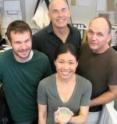Bacteria use 'toxic darts' to disable each other, according to UCSB scientists
Related images
(click to enlarge)
In nature, it's a dog-eat-dog world, even in the realm of bacteria. Competing bacteria use "toxic darts" to disable each other, according to a new study by UC Santa Barbara biologists. Their research is published in the journal Nature. "The discovery of toxic darts could eventually lead to new ways to control disease-causing pathogens," said Stephanie K. Aoki, first author and postdoctoral fellow in UCSB's Department of Molecular, Cellular, and Developmental Biology (MCDB). "This is important because resistance to antibiotics is on the rise."
Second author Elie J. Diner, a graduate student in biomolecular sciences and engineering, said: "First we need to learn the rules of this bacterial combat. It turns out that there are many ways to kill your neighbors; bacteria carry a wide range of toxic darts."
The scientists studied many bacterial species, including some important pathogens. They found that bacterial cells have stick-like proteins on their surfaces, with toxic dart tips. These darts are delivered to competing neighbor cells when the bacteria touch. This process of touching and injecting a toxic dart is called "contact dependent growth inhibition," or CDI.
Some targets have a biological shield. Bacteria protected by an immunity protein can resist the enemy's disabling toxic darts. This immunity protein is called "contact dependent growth inhibition immunity." The protein inactivates the toxic dart.
The UCSB team discovered a wide variety of potential toxic-tip proteins carried by bacteria cells –– nearly 50 distinct types have been identified so far, according to Christopher Hayes, co-author an associate professor at MCDB. Each bacterial cell must also have immunity to its own toxic dart. Otherwise, carrying the ammunition would cause cell suicide.
Surprisingly, when a bacterial cell is attacked –– and has no immunity protein –– it may not die. However, it often ceases to grow. The cell is inactivated, inhibited from growth. Similarly, many antibiotics do not kill bacteria; they only prevent the bacteria from growing. Then the body flushes out the dormant cells.
Some toxic tips appear to function inside the targeted bacteria by cutting up enemy RNA so the cell can no longer synthesize protein and grow. Other toxic tips operate by cutting up enemy DNA, which prevents replication of the cell.
"Our data indicate that CDI systems are also present in a broad range of bacteria, including important plant and animal pathogens such as E. coli which causes urinary tract infections, and Yersinia species, including the causative agent of plague," said senior author David Low, professor of MCDB. "Bacteria may be using these systems to compete with one another in the soil, on plants, and in animals. It's an amazingly diverse world."
The team studied the bacteria responsible for soft rot in potatoes, called Dickeya dadantii. This bacteria also invades chicory leaves, chrisanthemums, and other vegetables and plants.
Source: University of California - Santa Barbara
Other sources
- Bacteria use 'toxic darts' to disable each other, scientists sayfrom PhysorgThu, 18 Nov 2010, 19:20:32 UTC
- Bacteria use ‘toxic darts’ to disable each other, according to UCSB scientistsfrom Science BlogThu, 18 Nov 2010, 18:50:37 UTC


